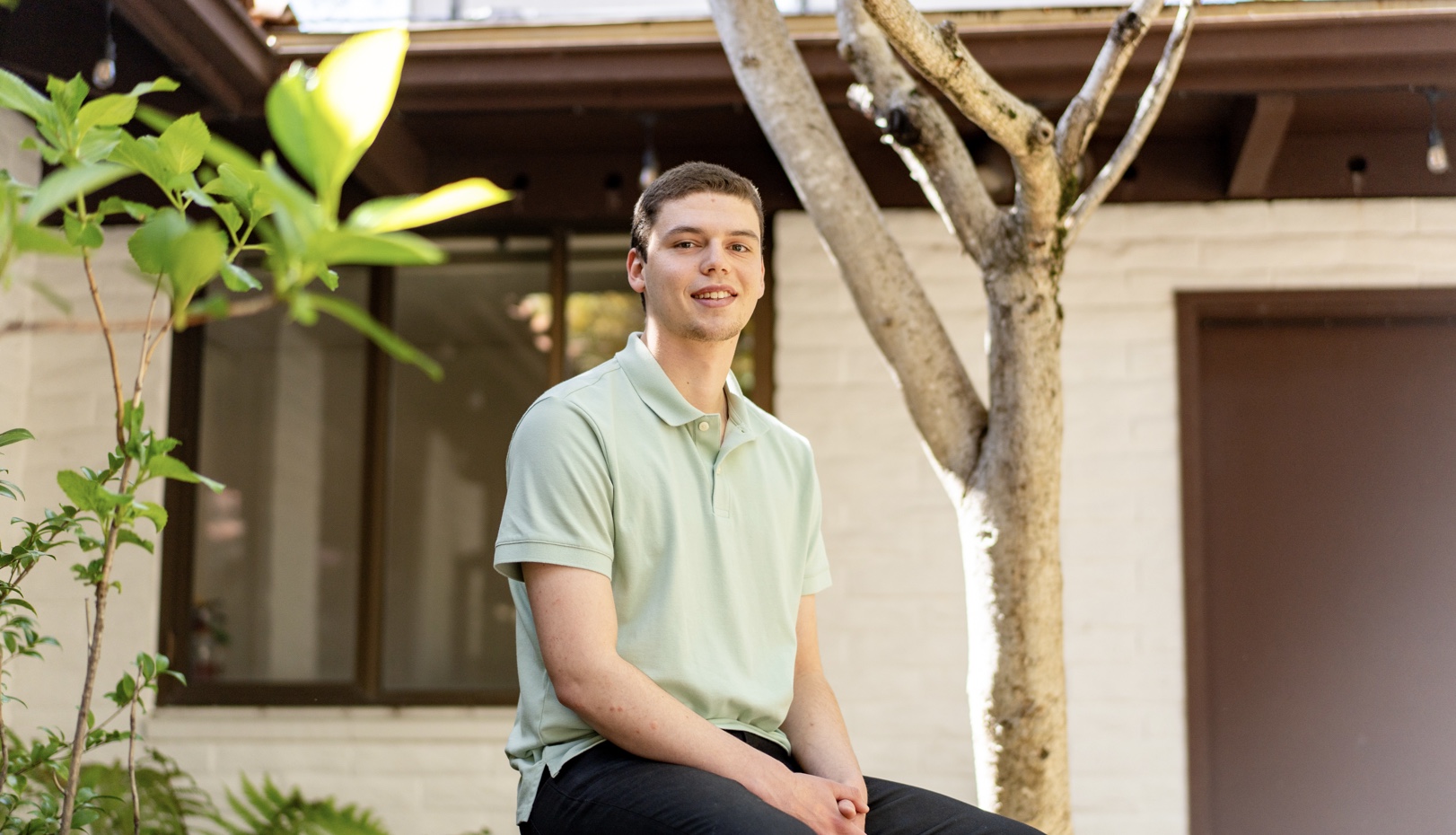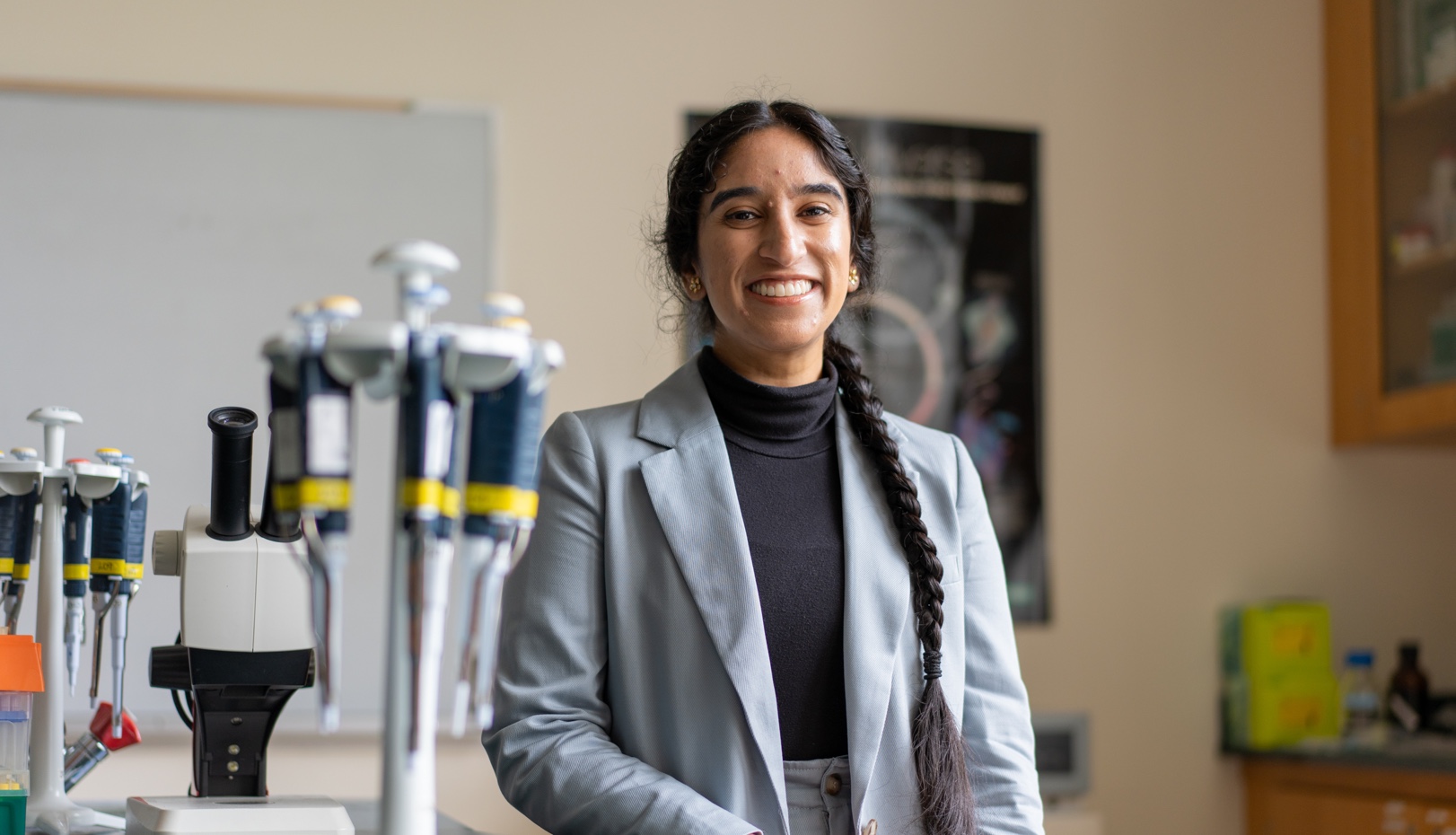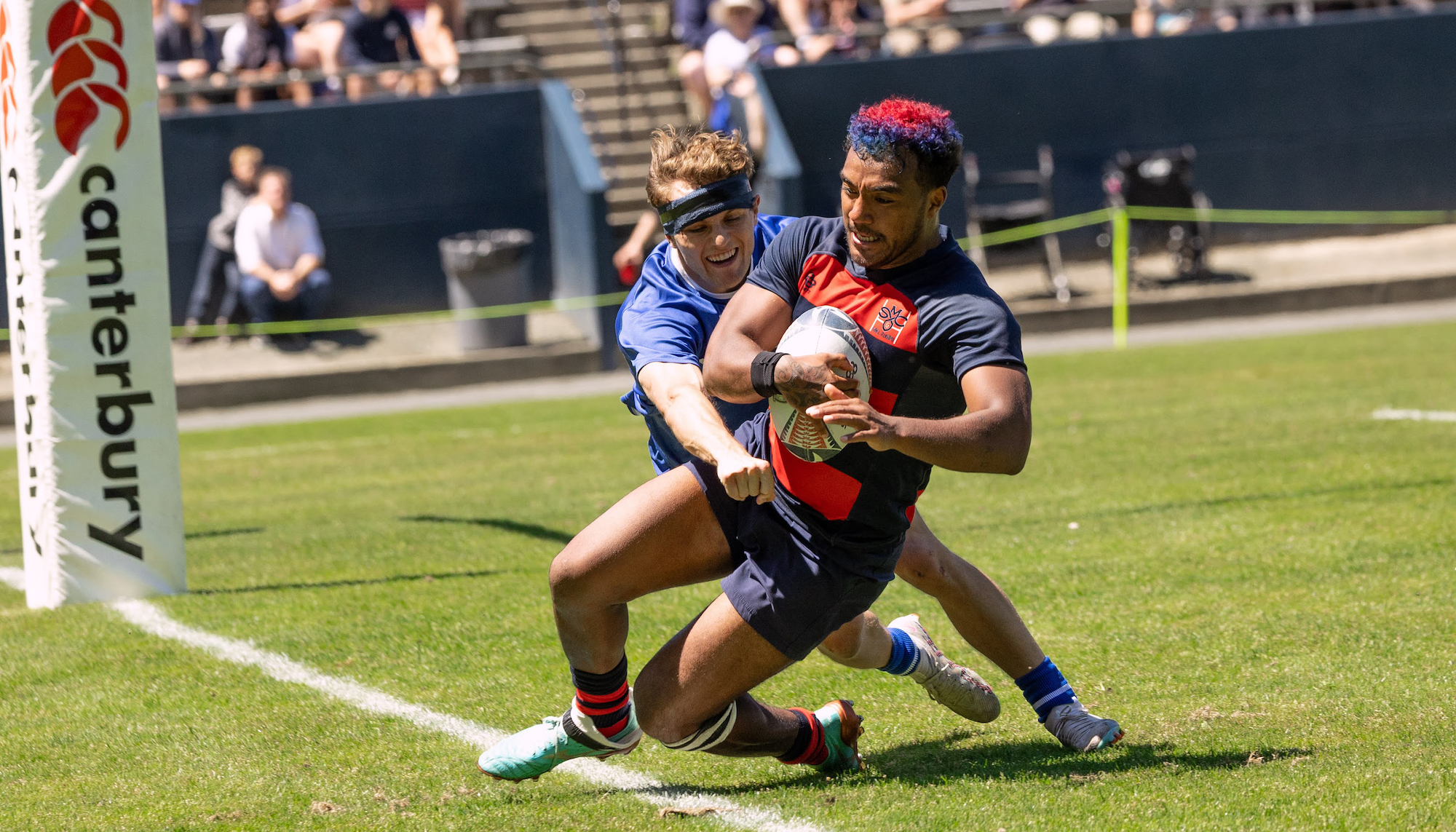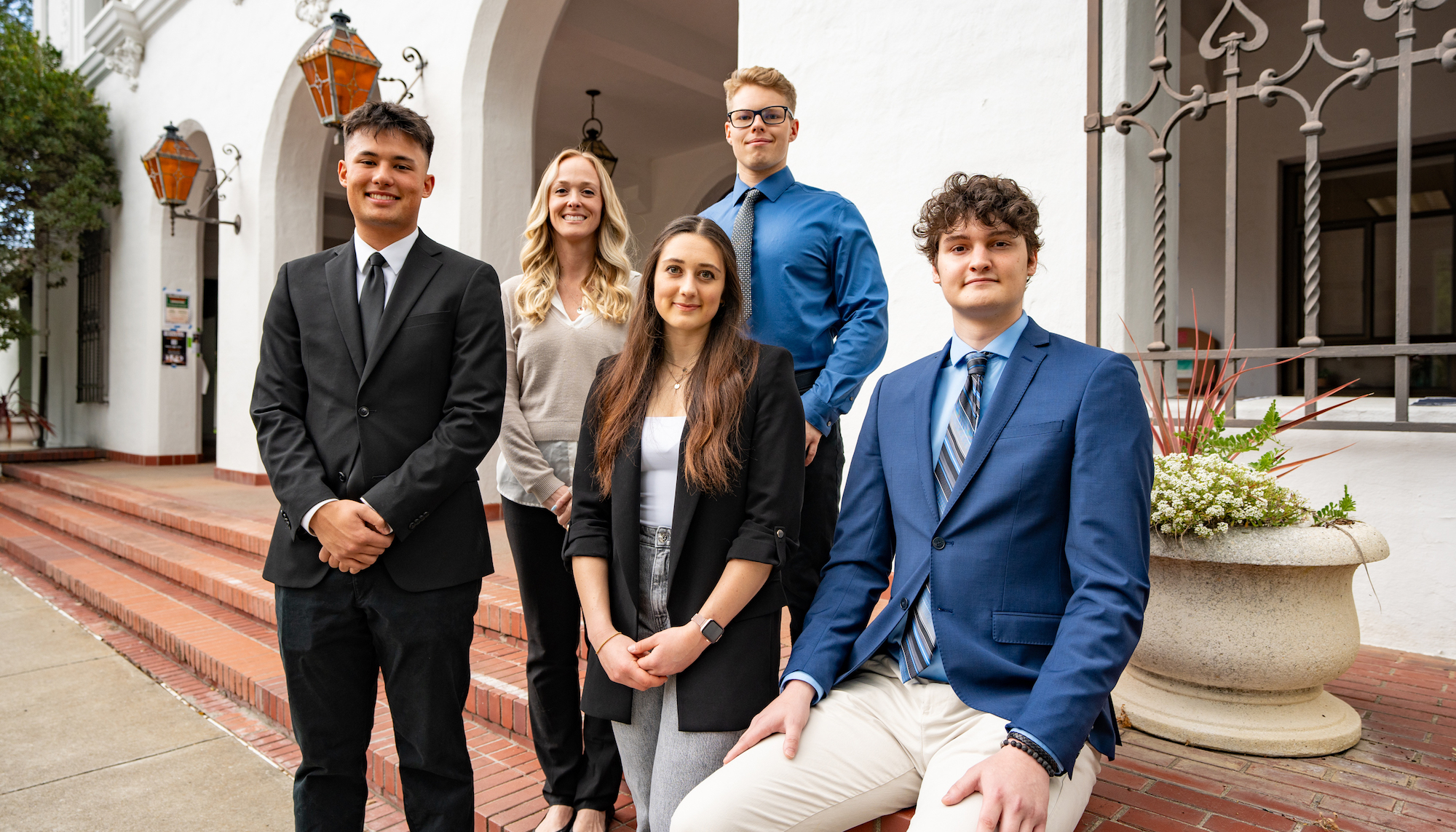
Apply what you know: The team from SMC that won the 2024 Lasallian Business Ethics Competition. From left, they’re Dylin Ganassin ’26, Stephanie Guilford ’25, Alexis Taliaferro ’25, August Blomquist ’26, and Jack Russo ’25. / Photo by Francis Tatem
Here’s How We Do Better: Meet the Winners of the 2024 Lasallian Business Ethics Case Competition
Five undergraduates from the School of Economics and Business Administration win an international case competition looking at what went wrong to create the Theranos debacle. And how to prevent those lapses in the future.
There was a moment in mid-April, during the international 2024 Lasallian Business Ethics Case Competition, when the team of undergrad business students from Saint Mary’s had finished their presentation, and now it was time for them to field questions from the judges. The team of two women and three men—students of three different faculty members in the School of Economics and Business Administration—had tackled with depth and insight the lapses of morality, oversight, media coverage, and more that enabled the company Theranos to become a cautionary tale of fraud run amok. The company peddled scientific testing that could not deliver what it claimed, but all the checks that should have prevented this failed. The Saint Mary’s students offered prescriptions for how to prevent such future train wrecks.
The competition itself took place among nine schools founded by the Brothers of the Christian Schools. Among the judges’ questions, along with the focus on the particulars of the case, one question zoomed back up to the 50,000 foot level and the premise of the competition in the first place: Of the Lasallian principles on which Saint Mary’s and other schools were founded, what was the chief one that was violated? And, in the aftermath, which principle might be used to set things aright?
Dylin Ganassin ’26, a Finance major in Caroline Burns’ course in Business Ethics and Social Responsibility, didn’t miss a beat. Respect for all people was clearly missing in action, he said—especially for the sick and vulnerable individuals who trusted the tests. And a commitment to social justice—perhaps taking the form of restitution paid to those whose medical decisions and lives were upended by falsified blood test results—is a natural next step.
The SMC team had prepared intensively and well over the month prior, and made their arguments with focus and clarity. At the end of the day, the judges rewarded them with the championship trophy for the competition.
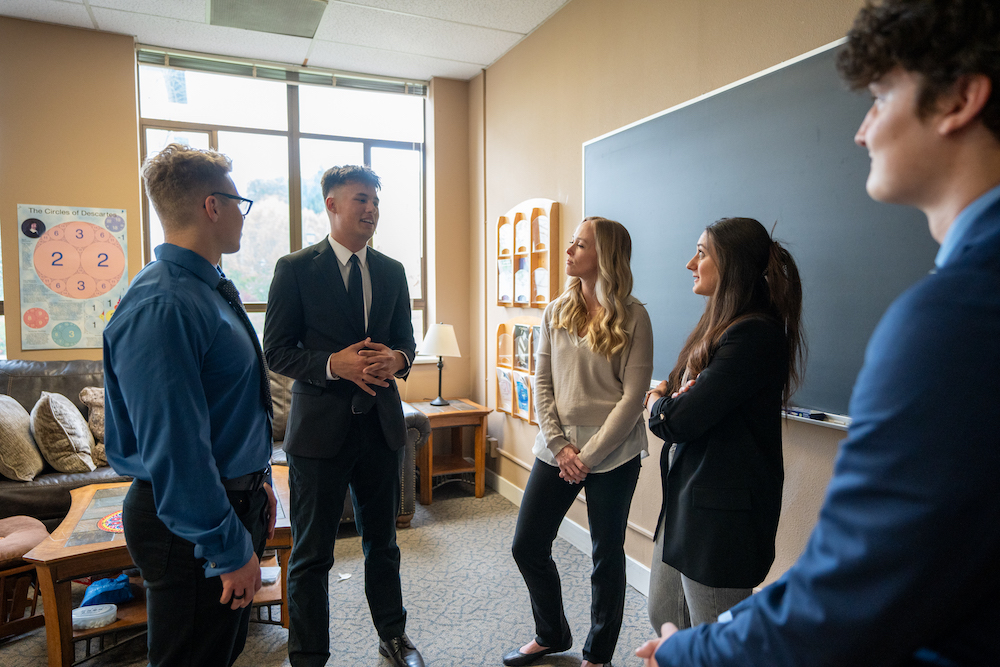
Layers and perspectives
Three of the SMC teammates—August Blomquist ’26, Jack Russo ’25, along with Dylin Ganassin—have been in class together with Professor Burns. For the competition, they were joined by Alexis Taliaferro ’25, a student in the course taught by Grant Rozeboom, and Stephanie Guilford ’25, who has been studying the subject with Lili Yan.
Talk to the students themselves, and they’ll underscore that coming from slightly different perspectives on business ethics was a real strength for the team; it ensured that they looked at different aspects of the case from a variety of angles, then worked their way toward presenting it through a common lens.
“There are just so many layers and different perspectives you could take,” says Blomquist, a Business Analytics major. “As we got to really talking about it, we saw each other's perspective, and then we had to work together. I initially was focusing mainly on Elizabeth Holmes—the cases of fraud, the retaliatory firings, and her relationship with Sunny Balwani. But there's always a bad apple. The problem is the board and the SEC allowed it to continue on far too long. It was really important to hear everyone else's perspectives, which led me to update my own.”
When Russo first read the case, “I was really focused on the board,” he says. “When we talked as a group, we realized there's a lot more at play—the government, the company's culture.” Russo, who transferred to Saint Mary’s at the beginning of this academic year and is majoring in Finance, notes that he and the other students had been aware of the Theranos case. They had also studied it in their course. “But I never really realized how extensive the failures were and how it was not just Holmes,” he says. “There were so many different groups that allowed it to happen.”
Alexis Taliaferro is in her first semester at Saint Mary’s, having transferred to SMC after beginning college in Austria. And like Blomquist, she at first zeroed in on Elizabeth Holmes, but in the initial meeting with teammates, she quickly realized that it was more important to delve into the role of the board. “Their job is to regulate, to prevent the bad apple from spoiling the whole bunch,” she says.
Stephanie Guilford was interested in exploring a legal solution. “When we were looking at the problem—how to prevent something like this going forward—I felt like we really need to focus on the regulation aspect and the governance.” Guilford is in her second semester at Saint Mary’s, having earned her associate’s degree years before, and returning to school this year while raising two small children. With a decade’s experience in the workforce, she felt like she brought to the team both a need to focus on the key arguments and an emphasis on how they needed to chip away at the work day-by-day in the tight four-week time frame.
Part of that work involved getting into the nitty gritty with how the company had managed to engage in activities that the Security and Exchange Commission and the Food and Drug Administration should, in theory, be able to stop. “We went deeper into how they were able to wiggle their way through,” is how Dylin Gannisin puts it, “and it shed a better understanding of just how deceitful this company was.”
The students are also very clear on how they benefited from dedicated coaching from the faculty who taught them. Caroline Burns regularly met with them after finishing her evening classes—with prep sessions sometimes stretching until 10:30 or 11 at night.
As a result, Blomquist says, the team developed a comprehensive understanding of the case. “And we were probably more confident as a whole knowing that we had a good understanding of everything going on,” he says.
Ganassin points to the late night sessions as good for both their content but also for the morale boost they offered. “I think our greatest strength was that we had committed professors. And all of us as students were committed.”
That’s another area where the students see things through a common lens. When it comes to Caroline Burns, Blomquist says, “It's super motivating to see how committed she is to business ethics—teaching the next generation of business leaders to make good ethical decisions to benefit the rest of society.”
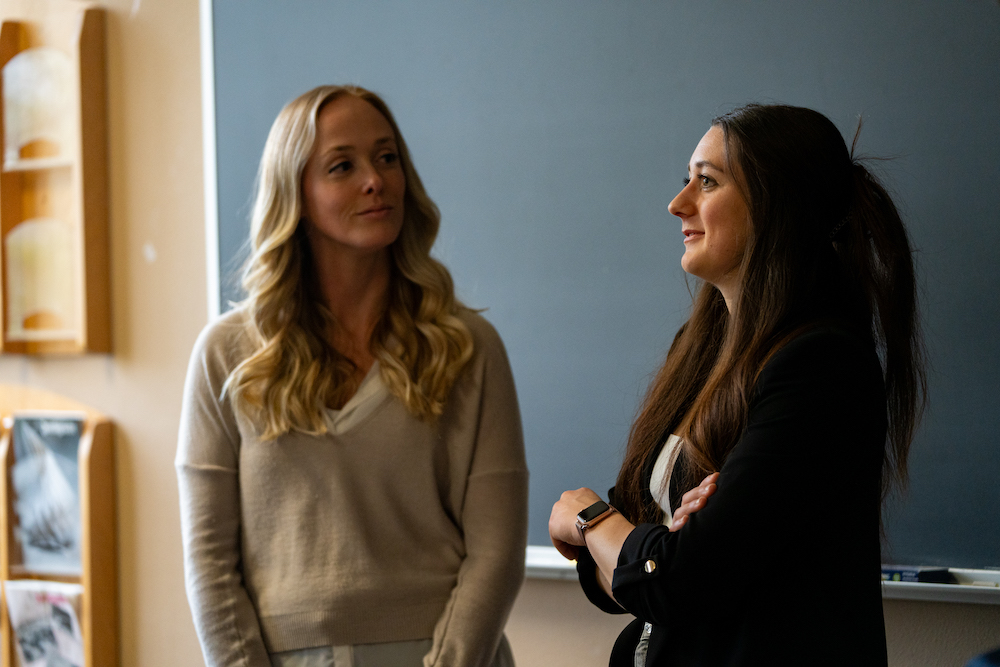
What does that mean going forward?
This is the third year of the Lasallian Business Ethics Competition. This year’s event took place on April 12 via Zoom, drawing competitors from Lasallian schools in New York, Minnesota, Illinois, Pennsylvania, Tennessee, and several schools in Mexico. Previous competitions have also had a Silicon Valley focus: tackling cases involving Apple iPhones and the ethics of cracking their security for criminal investigations; and on Facebook and the ethics of use of user data, as well as the effects of social media on mental health.
From Caroline Burns’ perspective, this year’s team brought remarkable motivation to their work. While there is no monetary prize, there is the reward of knowledge—and the experience they gained presenting in this format, and representing Saint Mary’s in international competition.
“What we're doing in business ethics is really trying to meld like ethical decision-making with business understanding, because you still have to do the usual things that you would do in business,” Burns says “Business education at Saint Mary's is special among business schools for its commitment to the common good and responsible business education.” Commerce is integral to our society; but at Saint Mary’s there's a greater willingness to put ethics at the fore and say, “It's okay to curtail profit-making for employee rights or for the environment or for environmental justice.”
Grant Rozeboom, who is a Professor of Moral Philosophy and Business Ethics, has helped organize the competitions from the outset. As he notes, teaching through case studies is part and parcel of graduate business education. For Lasallian schools, a focus on ethics is a natural fit. “The Theranos case is interesting because, while Elizabeth Holmes was really the focus of people's ire and media attention—in a lot of ways rightly—there are also interesting questions about the people who were supporting her and should have been holding her accountable.” Count among them members of the board of directors and venture capitalists who should have shown more due diligence. “Or the kind of fawning media coverage that she got that maybe should have been more skeptical,” he says. Or Walgreens, which put the devices in their stores in Arizona, sent a lab auditor, but then ignored the lab auditor’s concerns. “The net of culpability could get spread pretty broadly. We wanted a case for students to think through those issues. And then what does that mean going forward about better board of director practices or better startup investment practices and so on?”
For the faculty coaching the team, there’s a reward akin to that coaches of athletic teams feel, working with a group of talented and committed students preparing for competition. Part of the payoff is seeing students get deeper into the problems and solutions. “There's a wide range of prescriptions you can offer,” Rozeboom says. “‘Don't do fraud’—you can relatively quickly acknowledge that, but we don't really need much analysis or more in the way of prescriptions about that unless you think there's a gap in fraud-related law.” Things get really interesting when students reach what he calls “depth of knowledge of the business and institutional factors, but also in ethical reflection to say something incisive: Not just, ‘Here's what's wrong,’ but also, ‘Here is what even a smart, reflective person might miss. And here's a way in which our current institutional arrangement makes it easy for people to make that kind of mistake.’”
“For the students,“ says Grant Rozeboom, “it gives them a kind of lens to help them understand their own moral commitments and how they come to bear in business.”
Which brings us back to the place of teaching Business Ethics at Saint Mary’s. “Being in an institution like this makes it more natural to have a shared language, or at least shared bridge, for drawing on moral concerns,” Rozeboom says. “For the students, too, it gives them a kind of lens to help them understand their own moral commitments and how they come to bear in business.”
From Lili Yan’s perspective, the competition underscores the importance of students grappling with more than what the law and the market require—that’s the essence of social responsibility. She also notes that it’s important not to underestimate the important role Saint Mary’s plays in business education. “Though we're a small Catholic school, we are actually at the leading edge of business ethics education, and we know how valuable it is to shape an ethical business climate.”
Public trust and the common good
At the 2024 competition, after all teams had finished their presentations and Q&A sessions with the judges, all participants heard a keynote address by Nien-hê Hsieh, a co-author of the Theranos case and a professor of Business Administration at Harvard Business School. One of the points he made in his address: The most serious damage this case caused was, fundamentally, to public trust in the medical industry.
The Saint Mary’s team had zeroed in on that as a key element—and more extensively than other teams, August Blomquist notes.
“We identified pretty much the same things that the Harvard professor that wrote the case did,” is how Russo puts it. “And we were able to explicitly articulate all that in our presentation.”
So how does this work on the case fit in with what the students have been doing in their courses in Business Ethics?
“It was the perfect canvas to apply everything we’ve learned,” Russo says. “That includes the framework, the actual decision-making process, and how we've been taught how to think about a decision from an ethical standpoint.”
Russo grew up in the Lamorinda area, so Saint Mary’s was a place he knew well when he transferred here. And continuing his education with smaller class sizes and the opportunity to get to know professors better than where he had been is something he particularly values. “I felt like I could get a lot from here,” he says. As part of that: courses that would challenge him and push him forward. He’s hoping to work an internship connected to his major this summer.
Blomquist and Ganassin are both originally from Sacramento. Both are also participating in the ROTC program at UC Berkeley, an opportunity afforded Saint Mary’s students. Along with studies, Blomquist serves as treasurer for the martial arts club, where he also serves as an instructor. This summer, after travels in Europe, he’s planning on completing EMT training as well.
Along with his major, Ganassin is minoring in East Asian Studies. He is headed for Japan this summer, as part of his language training for the military.
Perhaps not coincidentally, Russo, Blomquist, and Ganassin also arrived at this semester with some coursework in philosophy already under their belts. For Russo, it was a course focused on settling moral controversies, which introduced him to Kantian ethics—a dimension of their case presentation. For Blomquist, it was a first-year course in Socratic philosophy. And for Ganassin, it was a class in Philosophy of Religion.
Alexis Taliaferro has already begun working an internship with PF Wealth Management. She is from Fairfield originally, so returning from Austria to Saint Mary’s certainly brought her much closer to home. The personal attention that she got from the admissions team, including Craig Means, who heads up transfer admissions for Saint Mary’s, was a key factor; SMC took the time to ensure she would get maximum credit for the coursework she had already completed.
Stephanie Guilford now lives in Brentwood, about 40 miles east of Saint Mary’s, and grew up in nearby Danville. She brings a decade of experience in the workforce in administrative roles, and she plans to start working on her MBA after graduating in December. “I was really impressed with everyone's ability to execute on the day of,” she says of her teammates. “We were working into the late hours, early mornings—living and breathing this. And we all pulled through.”
“You're trying to build a vision of a future where you create more ethical and more moral people,” says student Dylin Ganassin, “and the world needs that.”
The way Ganassin sees it, the experience with the competition is very much part of a bigger picture—not just in terms of its connection to the course in Business Ethics, but to a larger education mission. “You're trying to build a vision of a future where you create more ethical and more moral people—and the world needs that.”
Call that a sentiment the organizers of the competition would be heartened to hear. “It's true that only five students in a given year get to do this,” says Grant Rozeboom. “But really, it's continuous with what we're doing at Saint Mary’s. The students are selected out of the Business Ethics courses. It's not a kind of business ethics education that happens everywhere. The idea that a part of what it is to learn how to succeed in business, is to do so decently and in a value-centered way—I hope that all students here, and prospective students, know that this is a part of what they're getting.”
